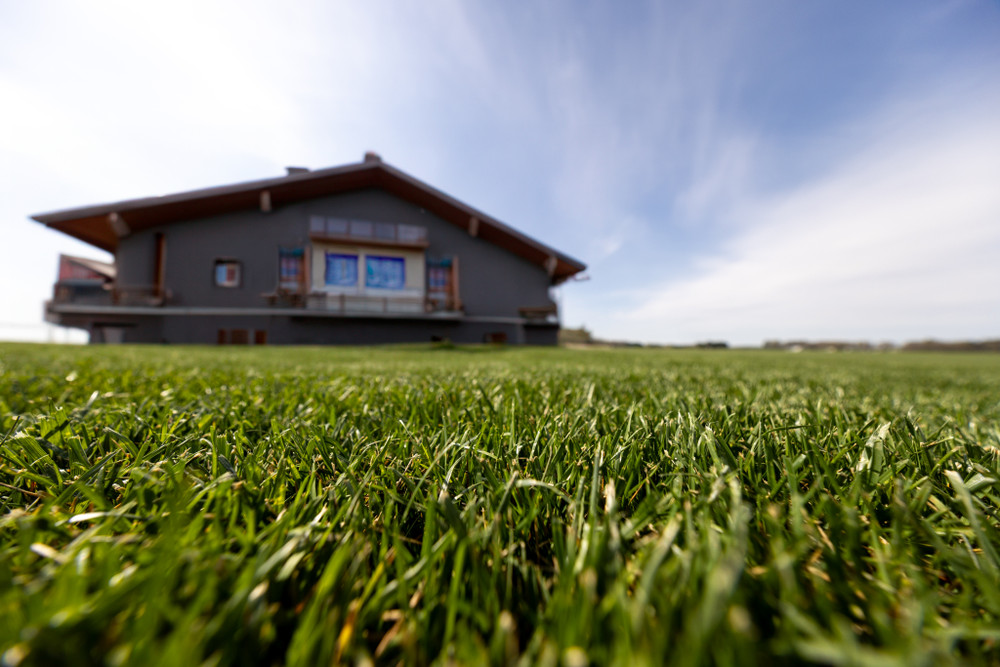Tall Fescue Sod: A Complete Guide for Homeowners
Posted by Farm2Yard on Aug 15th 2025
Tall Fescue Sod: A Complete Guide for Homeowners
What Is Tall Fescue?
Tall fescue (Schedonorus arundinaceus, formerly Festuca arundinacea) is a cool-season turfgrass known for its adaptability, durability, and year-round green color in many climates. Originally native to Europe, tall fescue was introduced to the United States in the early 1800s, first used primarily as a pasture grass before gaining popularity as a turf option for lawns and sports fields (Wikipedia).
By the mid-20th century, U.S. plant breeders developed improved turf-type tall fescues with finer leaf blades, denser growth, and better color, making them ideal for residential lawns (Pennington). Today, tall fescue is one of the most widely used cool-season turfgrasses across the transition zone and northern climates.
Defining Characteristics of Tall Fescue Sod
Tall fescue has a unique combination of traits that make it stand out from other turfgrasses like Kentucky bluegrass or perennial ryegrass:
-
Deep Root System – Roots can grow 2–3 feet deep under ideal conditions, giving tall fescue superior drought tolerance compared to many other cool-season grasses (Texas A&M AgriLife).
-
Medium-Coarse Leaf Blade – Turf-type tall fescues have a finer texture than traditional pasture varieties but still maintain a thicker blade than bluegrass (Oregon State University).
-
Bunch-Type Growth Habit – Tall fescue grows in clumps and does not spread via stolons or rhizomes. This means it won’t creep into garden beds, but it does require periodic overseeding to maintain density (Alabama Cooperative Extension).
-
Shade Tolerance – Performs well in partial shade, needing only 4–6 hours of sunlight per day, making it ideal for lawns with mature trees (ACES).
-
Cool-Season Growth – Thrives in temperatures between 60–75°F, staying green into late fall and greening up early in spring (Grounds Guys).
Why Homeowners Choose Tall Fescue Sod
1. Durability for Active Yards
Tall fescue’s deep root system allows it to withstand heavy foot traffic, making it a great choice for families with children and pets. As Jeff Hill, CEO of USA Sod, noted in our interview:
“You can have your kids trample on it. You can have football games and soccer games on it in your backyard. It is a wonderful sod for that.”
2. Year-Round Visual Appeal
In cooler climates, tall fescue maintains a green appearance most of the year, only going dormant in extreme summer heat or winter cold. Its medium to dark green hue provides a lush lawn without excessive fertilization (Grounds Guys).
3. Drought Resistance
Thanks to its deep roots, tall fescue can access water deeper in the soil profile, requiring less frequent irrigation than shallow-rooted grasses like bluegrass (Oregon State University).
4. Shade Performance
If your yard has large oaks or pines, tall fescue’s ability to grow with limited sunlight makes it a strong choice (ACES).
5. Adaptability to Soil Types
Tall fescue tolerates a wide range of soils, from sandy to clay, and is less sensitive to pH variations than many other turf species (Texas A&M AgriLife).
Maintenance Tips for a Healthy Tall Fescue Lawn
1. Mowing
-
Maintain a height of 2.5–4 inches.
-
Never remove more than one-third of the blade at a time to avoid stress.
-
Higher mowing heights improve drought and shade tolerance (ACES).
2. Watering
-
Water deeply and infrequently, about 1–1.25 inches per week, to encourage deep root growth.
-
During drought, tall fescue can survive with minimal irrigation, though color may fade temporarily (Oregon State University).
3. Fertilization
-
Apply a balanced lawn fertilizer in early fall and late spring.
-
Avoid heavy nitrogen applications in summer, which can stress the grass in heat (Purdue Turfgrass).
4. Weed Control
-
Use pre-emergent herbicides in early spring to control crabgrass.
-
Spot-treat broadleaf weeds like dandelions as needed.
-
Tall fescue has average weed resistance—good maintenance is key (Texas A&M AgriLife).
5. Overseeding
Because tall fescue does not spread laterally, overseeding bare spots in fall ensures a dense, healthy lawn (Pennington).
Ideal Homeowner Profile for Tall Fescue Sod
Tall fescue is best suited for:
-
Active families with kids or pets who need a durable playing surface.
-
Homes with partial shade, especially under large trees.
-
Property owners in the transition zone who want a cool-season grass that handles summer stress better than bluegrass.
-
Low-maintenance seekers who want fewer water demands without sacrificing a lush look.
Quick Comparison: Tall Fescue vs. Kentucky Bluegrass
|
Feature |
Tall Fescue |
Kentucky Bluegrass |
|
Root Depth |
2–3 feet (Texas A&M) |
6–8 inches |
|
Shade Tolerance |
High (ACES) |
Moderate |
|
Traffic Tolerance |
High (Grounds Guys) |
Moderate |
|
Drought Resistance |
High (Oregon State University) |
Low–Moderate |
|
Growth Habit |
Bunch-type (Pennington) |
Spreading |
Final Thoughts
Tall fescue sod offers a balance of durability, beauty, and adaptability that makes it a top choice for homeowners across a wide range of climates. Whether you’re dealing with active kids, patchy shade, or unpredictable rainfall, tall fescue delivers a resilient, year-round lawn with proper care.
As Jeff Hill of USA Sod summed it up:
“If you’ve got big trees and want a lawn that will stand up to family life, tall fescue is an ideal solution.”

